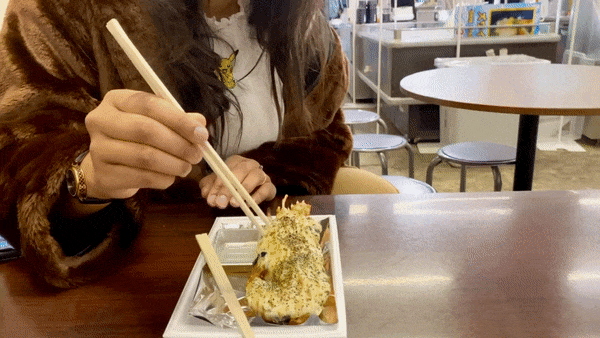

Osaka is Japan's second largest metropolitan city and of course, has an energetic and bustling night life, bright LED billboards and more food than you could ever stomach. It's actually known as the nation's kitchen because of it's plentiful delicious offerings. Apparently, there's a local expression, kuidaore, which means 'to eat oneself to ruin.' I feel personally attacked...
Dotonbori
- Opening hours: 24hrs



The heart of Osaka, Dotonbori is a vibrant and colourful area which can be best appreciated at night. A gastronomic wonderland, it's packed full of street food vendors, restaurants and izakayas (bars). Some of my favourite dishes sampled include:
- Takoyaki: one of Osaka's iconic dishes, Takoyaki are savoury, wheat-dough which are grilled and filled with the creamy dough mixture and a chunk of octopus. Tako = octopus, yaki = grilled. The portion of takoyaki is then garnished, usually with dried bonito flakes, dried green seaweed, mayonnaise and takoyaki sauce. However, there are plenty of variations available. From cheese toppings to BBQ sauce, you won't get bored.
- Baked cheese cake: have you ever seen those videos of jiggly cheesecake? Well, they originate from Japan and I was able to finally get my
handsmouth on these freshly baked delicacies from Rikuro Ojisan. Using cream cheese from Denmark, these super soft, moist cheesecakes have a layer of raisins at their base. - Melon pan: such a beautiful creation. Seeing characters in anime shows eating it, I always thought it was some sort of melon flavoured bread. Well, it is bread but it has no melon taste. Instead, it has a crispy, sugar-cookie top. The 'melon' comes from the criss-cross design which is thought to resemble the rind of a melon. Creative.
I stayed in Namba which is a 10 minute walk away from the party so when I came back from my day trips to Kyoto and Nara, I was able to enjoy the multitude of tastes that Osaka has to offer before heading off home.
Kuromon Market
- Opening hours: 8am-6pm, different vendors have different hours




During my quick visit to the market before catching (and missing) my train to Tokyo, I was able to sample some:
- Grilled, candied pineapple and sweet potato. The pineapple was juicy and delicious however, the sweet potato was sickly sweet
- Dried fruits. Perfectly moreish, highly recommend buying some as gifts for others, or yourself
- Grilled lobster with cheese and garlic butter. Tasty but not worth the price we paid for it
- Orange juice, fresh from the orange
- Eel which was re-heated in the microwave. Not a fan
Osaka Aquarium
- Opening hours: 10am-8pm
- Admission: 2450yen









I ended up spending several hours at the aquarium, taking snaps of the fascinating creatures, eating whale shark ice cream (ramune and vanilla flavoured) and absorbing the breathtaking view. I was able to observe feeding/cleaning time multiple times at different enclosures which made me feel that the animals were being well looked after.
Before leaving the aquarium, I popped into gift store and fell in love with a soft, cushiony, super-chubby seal plush. Osaka aquarium has become famous for their larger than life ringed seals. The most popular seal is Yuki-chan who is said to resemble a large, squishy steamed bun however, my heart was set on Arare-chan, the oldest ringed seal at the aquarium who is known for her sweet smile. I ummed and ahhed as to whether I really needed a £50 giant seal plush and decided yes, I definitely did. The cashier was kind enough to get a sealed (lol, get it? sealed) one from the back but damn, this chonk was hard to stuff into my luggage.
Daimaru Umeda Store
- Opening hours: 10am-8.30pm, closes 9pm Friday and Saturday



The food hall at Daimaru is called 'feast paradise' and I can see why. Bento boxes, baked goods, fried foods, delicious sweet treats and more. You can also find some 'luxury' fruit at the food hall. Fruits in Japan are already expensive however, there is a tradition of gifting luxurious fruits to others and that comes with a higher price tag. A melon I found in this department store was going for 16,200yen which is approx. £126!
As you can see, all I pretty much done in Osaka was eat and eat until I thought I was going to burst. My suitcase isn't the only thing that left Japan a couple of pounds heavier!
Jakhira.



































